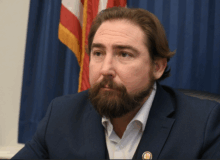Forty-Three years ago today the U.S. Supreme court issued their infamous Roe v. Wade decision which forced every state to leagalize abortion. Since then there have been over 58 Million babies slaughtered in their mother’s womb. Roe v. Wade was a very strange decision, the court ruled that the question of “when life began” was undeterminable, therefore a child is not a distinct person. But if they they didn’t know when life began why did they ignore the fact that it was possible they were killing a human life?
I tell this story often. Earlier in life I was pro-Abortion. But when my wife was pregnant with my first child went to all the appointments. During the first sonogram, my future daughter was looked like a baby and even sucked her thumb like a baby. That sonogram was done around the 16th week of pregnancy (dating the pregnancy term is not an exact science), if we had wanted we could have terminated that pregnancy. After she was born, she was most active the same exact times that she was active inside the womb. No one can ever tell me that my daughter during that first sonogram was not yet a human life (of course when she became a teenager I began to think she was no longer human but that is a much different story).
My friend and radio partner Tami Jackson, wrote a great post about that Roe v. Wade decision, part of which I share below:
Editor’s note: I wrote this article one year ago (I’ve updated only the anniversary year and the total of babies murdered), hoping to bring the woeful facts of the Roe decision to the fore. I mourn the loss of those babies, and the irreparable harm done to the mothers, fathers, and our nation’s collective conscience. America must repent and work to elect leaders who fear God and will restore a culture that chooses life. Tami Jackson
*******
Today marks the 43rd anniversary of the shameful Roe v. Wade decision, a Supreme Court decision made without precedent.
The Roe v. Wade timeline is worth remembering, or learning, since many were too young (or not yet born) when SCOTUS was hearing the case.
Roe v. Wade pitted fetal “right to life” against a woman’s “right to privacy.”
The Gospel coalition writes of Norma McCorvey (aka Jane Roe):
In 1969 Norma was 21 years old, divorced, and pregnant for the third time. (The first two children were placed for adoption.)
After seeking an abortion but finding out it was illegal, and then driving to an illegal clinic only to find it closed, adoption attorney Henry McCluskey referred her to two young lawyers in Dallas, Sarah Weddington and Linda Coffee.
Weddington (who had traveled to Mexico a couple of years earlier to have an abortion) was seeking a class-action lawsuit against the state of Texas in order to legalize abortion.
It was an unlikely party at the corner booth of Columbo’s pizza parlor in Dallas: two recent law-school grads in business suits sitting across the table from a rough and uneducated homeless woman.
The lawyers needed a representative for all women seeking abortions—one who was young, poor, and white. They just didn’t want her to cross state lines to get a legal abortion, or the case would be considered moot and dismissed.
Without money and five months pregnant, Norma was the ideal candidate. After downing several pitchers of beer, they agreed on using the pseudonym “Jane Roe.” (“Wade” referred to Henry B. Wade, the attorney general of Dallas.)
Norma McCorvey was unaware of the meaning of abortion:
Weddington and Coffee told Norma that abortion just dealt with a piece of tissue, and that it was like passing a period rather than the termination of a distinct, living, and whole human organism.
Abortion was a taboo topic in 1970, and Norma had dropped out of school at the age of 14. She knew that John Wayne movies talked about “aborting the mission,” so she thought it meant to “go back”—as in, going back to not being pregnant.
She honestly believed “abortion” meant a child was prevented from coming into existence.
There is much more to this post, please click here to read the rest of this story at Saving our Future.





